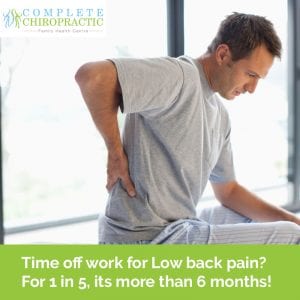Low back pain is one of those conditions which many of us assume are just a part of growing older, or is even par for the course in our field of employment. Although Chiropractic care can be remarkably effective for low back pain, the cultural attitude towards treatment of low back pain is still lacking – both the general public and the majority of GP’s often recommend rest alone. But what if rest alone just doesn’t work…..
Low back pain – it’s a huge cost.
Low back pain (LBP) is now the highest contributor of global disability worldwide.[1] In the UK in 2009, the direct health care costs of chronic back pain exceeded £1.5 billion.[2] Low back pain results in thousands of hours of lost work, impacts family life and, after some time, often begins to have a negative impact on our psychological and emotional health. We might choose to ignore LBP, we might try to laugh it off – but the statistics are clear, LBP is a major problem.
While many of us prefer the “soldier on” approach, employers are also to blame. Frankly, many employers adopt an incredibly short term view of their workforce health, viewing an episode of low back pain as a temporary condition, from which the employee simply needs to recover as soon as possible and return to work. What this approach fails to consider is that fact that studies show that back pain is typically episodic and is associated with recurrent work absenteeism.[3] In short, by failing to treat the cause of low back pain, and simply waiting for the symptoms to reduce (or trying to cover them up with pain killers) employers and employees alike are almost guaranteeing they will experience another episode of back pain in the near future… and so the cycle continues!
..and a substantial risk
It’s not just back pain itself which is the problem either – individuals with prevalent back pain are more likely to report future back injuries, work absences, and more comorbidities compared to workers without LBP.[4] If we step aside from our cultural view of back pain for a moment, this really makes sense – you wouldn’t continue to play your sport of choice with a sprained ankle or a torn ligament, so why continue in a physically demanding job or one which forces poor posture with an injured back?
For 1 in 5, it won’t just go away.
The body is an incredibly complex machine, so given enough time it will usually recover and back pain will often subside. This does not mean that the underlying issue has been resolved, just that any soft tissue damage or swelling which was causing discomfort has gone down. Those of us who don’t seek treatment for the underlying issue often return to work at this point, only to suffer another incident of back pain – often within weeks.
But what about if the pain didn’t subside? New research shows that this happens more often than we may have thought. Using information gathered as part of the Arizona State University Healthy Back Study (A large scale study into back pain) researchers tried to develop a model to predict how many of the affected individuals would be able to return to work after one, and six months. You might think that by six months, all the workers would have returned? – you would be wrong. In fact, 79% of workers returned to sustainable employment at 1 month, and this actually fell to 77% by 6 months. This means at least 2 in 10, or 1 in 5 workers are likely to still be out of employment or will not have returned to stable employment after a back-pain episode[5].
The study also suggested that sustainable employment at 1 month was predicted by initial back pain intensity, mental health-related quality of life and employer type, whereas at 6 physical and mental health-related quality of life and employer type were bigger factors. This suggests that while pain intensity does have a relationship to short term recovery (less painful conditions have a shorter recovery time) by the 6 month period, the initial problem had become far less significant than the overall effect that the ongoing pain has on an individual’s overall quality of life.
So what’s the solution?
The solution to lower back pain is proactive treatment! There are many effective ways to address lower back pain, the best one for you depends on the true nature of the pain. Many incidents of low back pain are actually caused by a common spinal condition known as vertebral subluxation – which itself is strongly linked with poor posture and weakened muscles in the core, and surrounding the spinal column. In other cases, soft tissue injury or even referred pain from a joint or postural impediment might be the cause, and here approaches such as sports therapy or massage can be highly effective.
The key point is that by addressing the underlying problem – not just waiting for the symptoms to go away, you can take a proactive approach to getting back to work, and back to life – rather than just rolling the dice and hoping you aren’t the one in five…
If low back pain or any kind of back pain is a problem for you, be sure to take advantage of our new patient special and grab yourself a professional consultation for just £25. We’ll have you on the road to a real recovery before you know it!
[1] Hoy DG, Smith E, Cross M, Sanchez-Riera L, Buchbinder R, Blyth FM, et al. The global burden of musculoskeletal conditions for 2010: an overview of methods. Ann Rheum Dis. 2014;73(6):982–9.
[2] Hong J, Reed C, Novick D, Happich M. Costs associated with treatment of chronic low back pain: an analysis of the UK General Practice Research Database. Spine. 2013;38(1):75–82.
[3] Cote P, Baldwin ML, Johnson WG, Frank JW, Butler RJ. Patterns of sick-leave and health outcomes in injured workers with back pain. Eur Spine J. 2008;17(4):484–93. Dunn KM, Jordan K, Croft PR. Characterizing the course of low back pain: a latent class analysis. Am J Epidemiol. 2006;163(8):754–61.
Hestbaek L, Leboeuf-Yde C, Manniche C. Low Back Pain: What Is The Long-term Course? A Review of Studies of General Patient Populations European Spine Journal 2003 (Apr); 12 (2): 149–165
[4] Cassidy JD, Cote P, Carroll LJ, Kristman V. Incidence and course of low back pain episodes in the general population. Spine. 2005;30(24):2817–23.
[5] Heather M. Shearer, Pierre Cote, Eleanor Boyle, Jill A. Hayden, John Frank, William G. Johnson Who will have Sustainable Employment After a Back Injury? The Development of a Clinical Prediction Model in a Cohort of Injured Workers J Occup Rehabil. 2017 (Sep); 27 (3): 445–455



